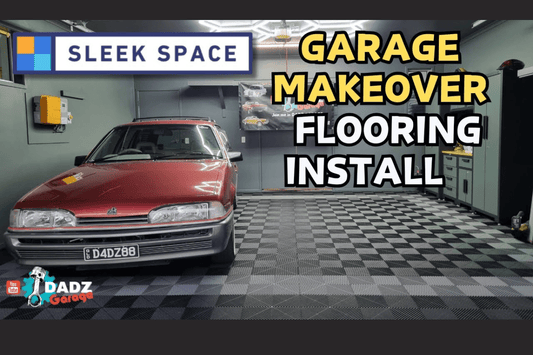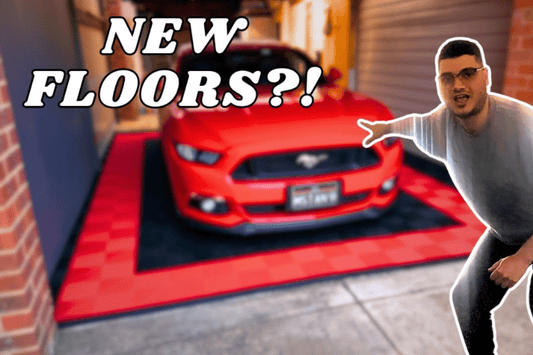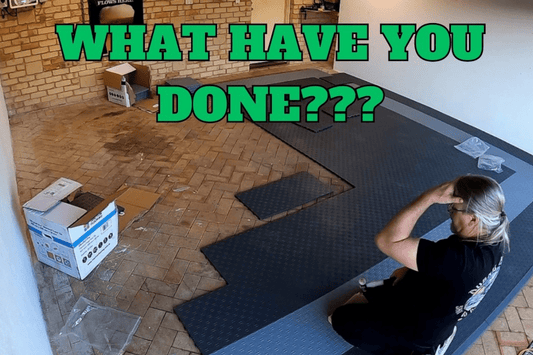Garage Floor Tiles in 2025: Everything We Know

Over the past few years, the humble garage has changed. What used to be a forgotten dusty corner of the house is now one of the most transformed spaces in Australian homes. From car enthusiasts building showroom-style setups to families creating multi-purpose zones for storage, workouts or hobbies, the modern garage has become part of the lifestyle.
At the centre of this shift are garage floor tiles.
At Sleek Space we’ve seen the evolution first-hand. What began with a few simple designs has grown into a complete ecosystem of modular garage flooring, lighting and storage. This guide is the honest take on everything we’ve learnt over the years—what works, what doesn’t and what you should know before you invest.
1. Why Garage Floor Tiles Are Redefining the Modern Garage
Epoxy used to be the default choice for anyone upgrading their garage. But the truth is, epoxy is messy, takes days to cure and often starts peeling or yellowing within a couple of years. Once hot tyres, moisture or humidity get involved, it begins to fail.
Garage floor tiles have changed that completely. They don’t need chemicals or surface prep, they’re ready in hours and can be removed or replaced tile by tile if needed. There’s no smell, no fumes and no downtime.
Modern interlocking tiles give your garage a professional engineered look. The clean geometry, uniform colour and subtle sheen turn a plain concrete floor into something worth showing off.
In 2025, more Australians are choosing garage floor tiles than ever before not just because they’re easier, but because they last and look good doing it.
2. What Garage Floor Tiles Are Made Of
The most common material for quality garage tiles is polypropylene, a high-impact thermoplastic used in everything from car parts to industrial flooring. It’s strong, non-porous and resistant to oils, chemicals and moisture.
But not all polypropylene is the same. Some suppliers cut costs by using low-grade recycled blends. These tiles often arrive with rough surface textures, inconsistent colours and a glossy finish that feels cheap. Over time they can warp or crack, especially under the weight of vehicles.
At Sleek Space we refined what we now call PrimeForm™, a performance-grade polypropylene blend developed after testing dozens of formulations to achieve the right balance of strength, flexibility and surface finish.
You can feel the difference underfoot and see it in the precision moulding. PrimeForm™ tiles lock together seamlessly, producing a smooth uniform surface that feels solid under load.
3. Open-Rib vs Solid Tiles: What’s the Difference?
Open-rib tiles feature ventilated grid-like surfaces. Dust, small debris and moisture pass through, keeping the visible surface clean even in working garages. That material collects in the channels beneath, so every few months you’ll need to vacuum or blow out the underside to remove built-up grit.
Solid tiles have a sealed textured surface. They don’t hide dust but they make cleaning easier. You sweep or mop what you see and that’s it. They’re ideal for show-style or cleaner environments where you want a continuous look.
There’s no universal better type, only what suits your use. Open-rib tiles are for garages that get wet or dirty often. Solid tiles suit enclosed spaces or when appearance is the focus.
4. The Truth About Dust and Maintenance
Tiles don’t eliminate dust entirely; nothing does. What they stop is concrete dusting—the fine powder that rises from bare slabs and coats everything you own. Once covered with tiles, that problem ends.
What remains is surface dust from tyres, air or movement.
- With open-rib tiles, most of it settles underneath and needs a deeper clean every few months.
- With solid tiles, it stays visible but is easy to sweep or vacuum.
A quick blower pass each week and an occasional deep clean are enough to keep a garage spotless.
5. Installation: Easier Than It Sounds
Installation is achievable as a DIY job. You’ll need a rubber mallet, tape measure and jigsaw for edge trims. Start from the garage door and work backwards. Leave a 5–10mm gap around walls or posts for expansion.
Most garages can be tiled in a few hours. The result feels instantly solid and quieter underfoot. Tiles can also be removed without damage if you move or reconfigure the layout. That flexibility is part of their appeal.
6. Cost, Value and Longevity
A standard double garage (about 6×6m) uses roughly 225 tiles. Quality tiles cost between $7 and $9 each depending on the style and finish, so a full garage floor installation usually lands between $1,575 and $2,000.
That may sound steep compared with epoxy flooring, but it’s a once-in-decades investment. Tiles last over 20 years with minimal maintenance. There’s no flaking, recoating or repainting. Over time, the cost per year is often lower than a cheap epoxy job.
Tiles also protect the slab underneath, preserving property value if you ever sell.
7. The Real-World Pros and Cons of Tiles Versus Epoxy
Advantages
- Fast, chemical-free installation
- Modular and replaceable design
- Resistant to moisture, stains and heat
- Comfortable and slightly insulated underfoot
- Adds visual order and polish to the garage
Limitations
- Open-rib tiles require occasional underside cleaning
- Slight hollow sound compared with concrete (varies by subfloor)
- Quality varies widely between brands; cheap imports often don’t last
Understanding these trade-offs early helps avoid disappointment later.
8. Design, Colour and Function
Garage floors in 2025 aren’t just practical; they’re part of home design. Neutral greys and blacks remain popular, while muted tones like stone beige, tactical olive and night blue are growing fast.
Combining colours for parking zones, borders or chequered layouts adds visual depth. The best floors balance restraint and precision—enough pattern to feel intentional, not enough to distract from the cars and lighting above.
9. Environmental and Health Considerations
Modern tiles are recyclable and don’t require adhesives or VOC-heavy coatings. Installation produces no fumes and no need for sanding or etching.
Epoxy and paint systems still rely on solvents and curing agents that release VOCs for days. For families using the garage as a gym or play area, tiles offer a safer environment.
10. What 2025 Homeowners Are Looking For
Garage flooring choices now reflect broader lifestyle trends: flexibility, design and longevity. People want floors that look great, don’t fail in five years and don’t require professionals to maintain.
Tiles have become the default solution not because of marketing but because they solve long-term problems cleanly. They’re a structural upgrade that modern homes demand.
The Bottom Line
A good garage floor doesn’t just sit under your car; it defines the space. The right tiles turn the garage from a utility zone into part of the home.
Choose quality materials, plan your layout and maintain it lightly. Do that and your garage will stay functional, clean and sharp-looking for decades, not seasons.
That’s the quiet truth behind why garage floor tiles Australia have taken over in 2025.



